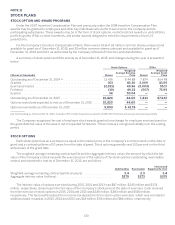American Express 2015 Annual Report Download - page 150
Download and view the complete annual report
Please find page 150 of the 2015 American Express annual report below. You can navigate through the pages in the report by either clicking on the pages listed below, or by using the keyword search tool below to find specific information within the annual report.
VALUATION TECHNIQUES USED IN THE FAIR VALUE MEASUREMENT OF FINANCIAL ASSETS AND
FINANCIAL LIABILITIES CARRIED AT FAIR VALUE
For the financial assets and liabilities measured at fair value on a recurring basis (categorized in the valuation
hierarchy table above) the Company applies the following valuation techniques:
Investment Securities
When available, quoted prices of identical investment securities in active markets are used to estimate fair value.
Such investment securities are classified within Level 1 of the fair value hierarchy.
When quoted prices of identical investment securities in active markets are not available, the fair values for the
Company’s investment securities are obtained primarily from pricing services engaged by the Company, and the
Company receives one price for each security. The fair values provided by the pricing services are estimated using
pricing models, where the inputs to those models are based on observable market inputs or recent trades of similar
securities. Such investment securities are classified within Level 2 of the fair value hierarchy. The inputs to the
valuation techniques applied by the pricing services vary depending on the type of security being priced but are
typically benchmark yields, benchmark security prices, credit spreads, prepayment speeds, reported trades and
broker-dealer quotes, all with reasonable levels of transparency. The pricing services did not apply any adjustments to
the pricing models used. In addition, the Company did not apply any adjustments to prices received from the pricing
services.
The Company reaffirms its understanding of the valuation techniques used by its pricing services at least annually.
In addition, the Company corroborates the prices provided by its pricing services for reasonableness by comparing the
prices from the respective pricing services to valuations obtained from different pricing sources. In instances where
price discrepancies are identified between different pricing sources, the Company evaluates such discrepancies to
ensure that the prices used for its valuation represent the fair value of the underlying investment securities. Refer to
Note 5 for additional fair value information.
Derivative Financial Instruments
The fair value of the Company’s derivative financial instruments is estimated by third-party valuation services that
use proprietary pricing models or by internal pricing models, where the inputs to those models are readily observable
from actively quoted markets. The pricing models used are consistently applied and reflect the contractual terms of
the derivatives as described below. The Company reaffirms its understanding of the valuation techniques used by the
third-party valuation services at least annually. The Company’s derivative instruments are classified within Level 2 of
the fair value hierarchy.
The fair value of the Company’s interest rate swaps is determined based on a discounted cash flow method using
the following significant inputs: the contractual terms of the swap such as the notional amount, fixed coupon rate,
floating coupon rate (based on interbank rates consistent with the frequency and currency of the interest cash flows)
and tenor, as well as discount rates consistent with the underlying economic factors of the currency in which the cash
flows are denominated.
The fair value of foreign exchange forward contracts is determined based on a discounted cash flow method using
the following significant inputs: the contractual terms of the forward contracts such as the notional amount, maturity
dates and contract rate, as well as relevant foreign currency forward curves, and discount rates consistent with the
underlying economic factors of the currency in which the cash flows are denominated.
Credit valuation adjustments are necessary when the market parameters, such as a benchmark curve, used to
value derivatives are not indicative of the credit quality of the Company or its counterparties. The Company considers
the counterparty credit risk by applying an observable forecasted default rate to the current exposure. Refer to Note
14 for additional fair value information.
139
























